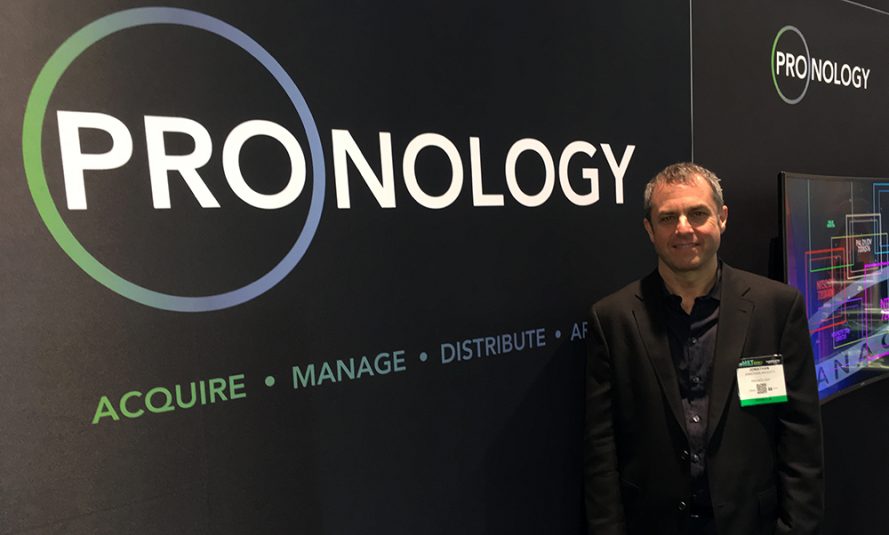NAB Reflections: Pronology’s Jon Aroesty on IP Conversion, Encoding, 4K
New StreamFile Core transcodes between IP and file-based
Pronology, which has seen use of its mRes multi-resolution encoding system skyrocket over the past two years, introduced the StreamFile Core IP–to–file-based conversion system at NAB 2017. The NAB Best in Show winner allows Pronology’s mRes encoder to take in IP streams (currently NDI, with more formats on the way) and output digital files (currently MP4, with more formats coming). In addition, Pronology showcased its Screener product, a multichannel, file-based production screening device that records universally playable MP4 files.
SVG sat down with Pronology President/founder Jon Aroesty during NAB 2017 to discuss StreamFile Core, Screener, the company’s plans for 4K, and the evolution of live sports production.
How does StreamFile Core work?
Essentially, we have added the ability for our mRes encoder to bring in IP streams. That’s exciting because it takes our big, robust loop record system to the next level and integrates it with IP technology. At the same time, we wanted to build some things that are really simple and easy to deploy at a much lower price point.
The StreamFile Core application [transcodes] between IP and file-based. I haven’t seen anything else that’s this simple. If I have an IP stream coming in, all I have to do is go to my setup and choose my IP standard — NDI, for example. Then I choose my storage destination. I hit record, and I’m now creating an MP4 file from an IP stream to a storage location. This is currently available for NDI-to-MP4 [conversion] for Windows. The Mac version is coming very soon, and we’re adding the other [IP and file-based formats] to the system.
We already had the experience in transcoding and encoding, so the next level was to go to IP and simplify this. We took the backend engine that makes all these files, which is what all the work’s gone into over the last couple years, and use it in a really simple way for IP. The architecture’s all there already. This is something you can use in the real world in an edit system.
What else is new at NAB 2017 for Pronology?
We have a very interesting tool called Screener, which is a replacement tool for making screening copies on DVD at a very low entry price. It makes two channels of universally playable MP4s, and the learning curve is about five minutes.
For sports, imagine in the truck you have to send out screening copies for a producer or screening copies of a show open or the choreographer for the halftime show wants to see something in advance. You just hit record; you can drop these in for social-media upload or to a portable USB drive. For instance, I type not for air, I can watermark internally, and it burns timecode internally. And it makes really simple, universally playable MP4 files.
In a sports environment, this can be a great tool for preproduction or to give someone a copy of the show when it’s over. That’s not a hi-res copy that can fit on a thumb drive; you can watch it on an airplane or review. It’s a very simple user interface at $995 for the software. It is now being used in several of the NEP Denali trucks, with others on the way.
Use of the mRes encoder has grown over the past couple of years. How do you see Pronology evolving as a company?
Our background is that we’re users. I’m an operator first and foremost. I’m out doing shows week after week, working with this equipment, from sports to awards shows to something like TED Talks. What we’ve found is that, as the industry evolves, the production teams, tech managers, and engineers are much more proficient in workflow design but their days are too short. So they’re relying on Pronology to help them build these workflows and then integrate them with their existing systems or vendors, like file acceleration, NLEs, and encoding and transcoding products. They’ve learned that they can depend on us to consult and help them with their integration pain points because of our ability to quickly develop tools and work with other vendors and integrate with other software tools. We have really concentrated a lot on that.
I mentioned TED Talks as an example. They have a very, very, very smart in-house skilled technical team. And they’ve adopted mRes and, with a few minor tweaks, built their own file-acceleration system, as well as their own screening and archive system. mRes played right into their whole metadata scheme. We found ourselves over the last couple years integrating much closer at that level as well as continuing very, very high-level support for all of our customers.
How are you preparing for the potential rise of 4K production?
We are now part of the TICO Alliance for compression. We’re doing TICO compression for our 4K work right now. mRes allows you in real time, or faster than real time, to make all the various file types that are compatible with today’s NLE systems. That applies to 4K as well. Our relationship with the TICO Alliance has allowed us to optimize some of the hardware we have for 4K, as well as for IP. We’re posturing ourselves to be ready for 4K with both encoding and management of those files.

